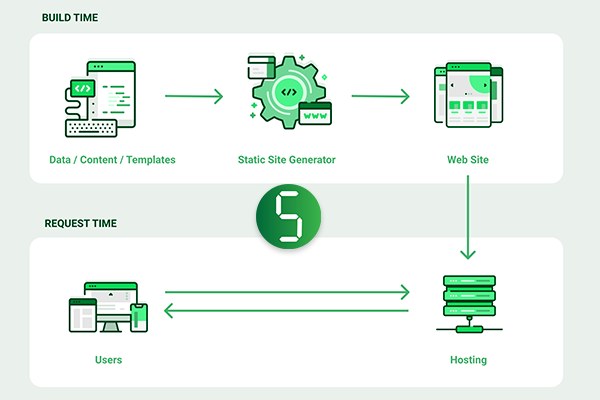Website Development
Website Development refers to building, creating, developing and maintaining websites in a presentable form for the businesses to deal with a large range or globally through the internet.


Website Development refers to building, creating, developing and maintaining websites in a presentable form for the businesses to deal with a large range or globally through the internet.


Website Development refers to building, creating, developing and maintaining websites in a presentable form for the businesses to deal with a large range or globally through the internet. The main reason for the functioning of the website is majorly concerned with the programming and coding languages. It includes aspects such as website design, website publishing, website programming, and database management.


The term static means fixed. Static websites are the basic and a simple website to create. It just works as a visiting card of a company. A Static Website does not require any Website programming or database design and can be built by simply creating a few HTML pages and publishing them to a Web server. A static website contains Website pages with fixed content which means the content of each page does not change unless it is manually updated by the website developer. Every page of a static website is coded in HTML and shows the same information to each and every visitor. If you want to do the same thing on the two pages of a static website like adding footer then your developer must do it twice on both the pages. This is clearly a straightforward concept that these websites are rigid and only works with HTML coding. A normal person with no technical knowledge about coding can not perform this task, only your developer can do.
Dynamic websites are very good for the businesses who want to extend and grow in this competitive world. It is especially suitable for large sites that contain hundreds or thousands of pages and the more your business website has web pages the more are the chances to grow because it helps to show what all your business does very effectively to the customers. These sites include HTML programming for the basic structure and Web scripting code, such as PHP or ASP are used to design and develop the advanced structure of the websites, also it uses different other coding languages like javascript etc. depending upon the requirements. Dynamic pages contain information in a database and it changes to give content depending on the user, the time of the day, the user's native language, their search performance and other factors. Dynamic websites give you an option of a content management system (CMS) that makes it simple even for a non-technical person to create and update the content of the site.

.png)
E-Commerce websites are designed and developed for doing E-Commerce business. E-Commerce is also known as e-Business or electronic business. It is described as the sale and purchase of goods and services over the internet. It involves transferring of data and funds between two or more parties electronically. A lot of consumers are now preferring online shopping rather than going to a physical marketplace as it has become an easy and convenient mode of shopping. Keeping the same concept in mind, E-commerce websites are defined and designed that allows you to sell your goods, digital products or services online to your customers without any barrier. This website eliminates your limit of selling goods and services only in specific areas. There are so many benefits of eCommerce websites and now most of the traders are preferring eCommerce websites over physical shops as it is the best way to make a bit of extra profits.
We always listen and understand the requirements of you before we start.
We do search for the latest technical solutions and plans to implement.
After Creating the best plan we work orderly and effectively for you to reach your goals.
Check out our website and testimonials to have a clear picture of worthwhile results.
If you like our works and have a project,contact us now

We provide several secure and fast services within time.
Swimming hundreds of feet beneath the ocean’s surface in many parts of the world are prolific architects called giant larvaceans. These zooplankton are not particularly giant themselves (they resemble tadpoles and are about the size of a pinkie finger), but every day.
readmoreSwimming hundreds of feet beneath the ocean’s surface in many parts of the world are prolific architects called giant larvaceans. These zooplankton are not particularly giant themselves (they resemble tadpoles and are about the size of a pinkie finger), but every day.
readmoreSwimming hundreds of feet beneath the ocean’s surface in many parts of the world are prolific architects called giant larvaceans. These zooplankton are not particularly giant themselves (they resemble tadpoles and are about the size of a pinkie finger), but every day
readmoreSwimming hundreds of feet beneath the ocean’s surface in many parts of the world are prolific architects called giant larvaceans. These zooplankton are not particularly giant themselves (they resemble tadpoles and are about the size of a pinkie finger), but every day
readmoreSwimming hundreds of feet beneath the ocean’s surface in many parts of the world are prolific architects called giant larvaceans. These zooplankton are not particularly giant themselves (they resemble tadpoles and are about the size of a pinkie finger), but every day.
readmoreSwimming hundreds of feet beneath the ocean’s surface in many parts of the world are prolific architects called giant larvaceans. These zooplankton are not particularly giant themselves (they resemble tadpoles and are about the size of a pinkie finger), but every day.
readmoreSwimming hundreds of feet beneath the ocean’s surface in many parts of the world are prolific architects called giant larvaceans. These zooplankton are not particularly giant themselves (they resemble tadpoles and are about the size of a pinkie finger), but every day
readmoreSwimming hundreds of feet beneath the ocean’s surface in many parts of the world are prolific architects called giant larvaceans. These zooplankton are not particularly giant themselves (they resemble tadpoles and are about the size of a pinkie finger), but every day
readmoreSwimming hundreds of feet beneath the ocean’s surface in many parts of the world are prolific architects called giant larvaceans. These zooplankton are not particularly giant themselves (they resemble tadpoles and are about the size of a pinkie finger), but every day.
readmoreSwimming hundreds of feet beneath the ocean’s surface in many parts of the world are prolific architects called giant larvaceans. These zooplankton are not particularly giant themselves (they resemble tadpoles and are about the size of a pinkie finger), but every day.
readmoreSwimming hundreds of feet beneath the ocean’s surface in many parts of the world are prolific architects called giant larvaceans. These zooplankton are not particularly giant themselves (they resemble tadpoles and are about the size of a pinkie finger), but every day
readmoreSwimming hundreds of feet beneath the ocean’s surface in many parts of the world are prolific architects called giant larvaceans. These zooplankton are not particularly giant themselves (they resemble tadpoles and are about the size of a pinkie finger), but every day
readmoreCopyright © 2020 Sysrover - All rights reserved